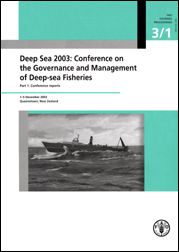|
Shotton, R. (ed.)
Deep Sea 2003: Conference on the
Governance and Management of Deep-sea Fisheries.
Part 1: Conference reports.
Queenstown, New Zealand, 1-5 December 2003.
FAO Fisheries Proceedings. No.
3/1. Rome, FAO. 2005. 718p.
Abstract
The first of these two-volume Proceedings contains papers
presented at Deep Sea 2003: Conference on the Governance and Management of
Deep-sea Fisheries that was held in Queenstown, New Zealand from 1 to 5 December
2003. They include the Conference opening statements and the keynote addresses
for the seven theme sessions, which covered the topics of (i) environment,
ecosystem biology, habitat, diversity and oceanography; (ii) population biology
and resource assessment; (iii) harvesting and conservation strategies for
resource management; (iv) technology requirements; (v) monitoring, compliance
and controls; (vi) review of existing policies and instruments; and (vii)
governance and management. A review by a group of selected experts on these
themes, as presented at the Conference, is also provided and gives their
personal views. The perspectives of the Conference Steering Committee, as
regards the general conclusions of the Conference, are provided in terms of what
are considered necessary to address the issues of deep-sea fisheries governance
and management and the programme elements that must be undertaken if deep-sea
fish resources are to be sustained, their habitat protected to ensure its
productivity and appropriate concern of protection of deep-sea
biodiversity.
The second volume of the Proceedings consists of two parts.
Authors who presented posters at Deep Sea 2003 were invited to provide more
detailed papers, based on their posters, for the Proceedings and the papers of
those authors who have done so are at the beginning of the volume. The
subsequent part contains papers presented at four workshops held at the
University of Otago, Dunedin from 27 to 29 November 2003, the week prior to the
main Conference in Queenstown. These workshops addressed the topics of (i)
assessment and management of deepwater fisheries; (ii) management of small-scale
deep-sea fisheries; (iii) conservation and management of deepwater fisheries;
and (iv) bioprospecting in the high seas. |
